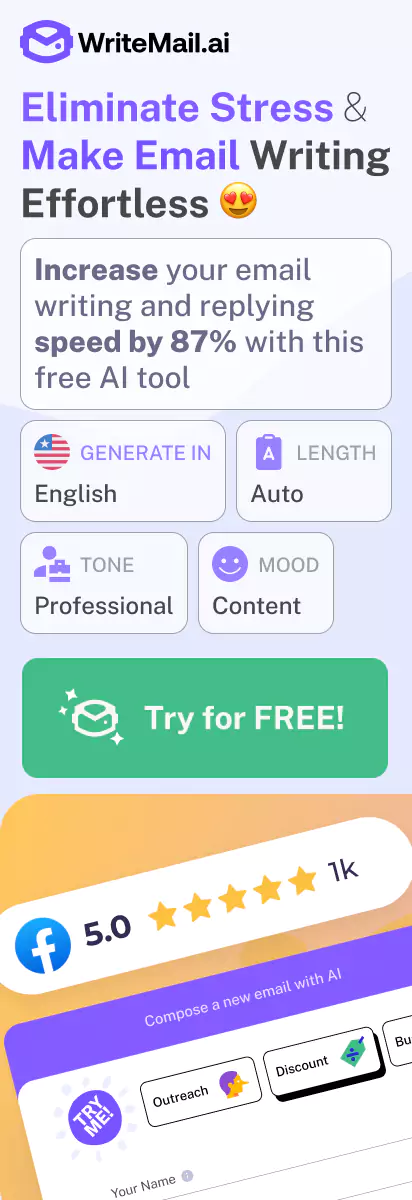Have you ever spent 20 minutes crafting the perfect email only to have it disappear into the void of your recipient’s inbox? I certainly have, and that sinking feeling of “did they even see it?” is something I wouldn’t wish on anyone. The hard truth is that your brilliant email content means absolutely nothing if no one opens it in the first place.
Here’s a statistic that changed how I approach every single email I send: According to recent research by Litmus, professionals receive an average of 121 business emails per day, but open only 34% of them. The difference between being read or being ignored often comes down to just a few carefully chosen words in your subject line.
The good news? When you implement the subject line techniques I’m about to share, you can boost your email open rates by an impressive 45%. I’ve tested these approaches across thousands of emails and multiple industries, and the results are consistently remarkable.
Think about what this means for your daily work life. When you’re trying to get a response from that busy client, close that important deal, or simply get your team to actually read your update, these subject line formulas give you a significant advantage in a crowded inbox.
In this guide, I’ll walk you through the psychology behind high-performing subject lines, show you exactly which phrases trigger opens (and which ones trigger spam filters), and give you customizable templates you can start using today. You’ll also discover how subtle timing factors can further amplify your open rates beyond what the subject line alone can achieve.
Ready to ensure your messages actually get read? Let’s dive into the subject line strategies that will transform your email effectiveness immediately…
Essential Elements of Professional Subject Lines That Get Opened
When you’re competing for attention in a crowded inbox, your subject line is doing the heavy lifting. I’ve found that crafting the perfect subject line is both an art and a science. Let’s dive into the elements that make professional subject lines irresistible to open.
Optimal Length for Professional Subject Lines
You might be wondering exactly how long your subject lines should be. According to research by Return Path, subject lines with 61-70 characters have the highest read rates at 17%. However, with mobile devices now accounting for over 60% of email opens, I recommend you keep your subject lines under 50 characters whenever possible.
Here’s what you should consider about length:
- Mobile optimization: Most mobile devices display only 30-40 characters of your subject line, so put your most important information up front.
- Desktop sweet spot: For desktop-targeted emails, aim for 50-60 characters to maximize visibility while providing sufficient detail.
- Preview text leverage: Remember that you can use preview text to extend your message beyond the subject line.
When in doubt, I suggest erring on the side of brevity. A concise, powerful subject line will almost always outperform a lengthy one that gets cut off.
Strategic Use of Action Verbs and Power Words
The difference between a subject line that gets ignored and one that gets opened often comes down to your choice of words. I’ve seen open rates increase dramatically when you use strong action verbs that create immediate mental images.
High-impact action verbs to consider:
- Transform (instead of “change”)
- Secure (instead of “get”)
- Boost (instead of “increase”)
- Slash (instead of “reduce”)
- Unveil (instead of “show”)
Power words that trigger curiosity and emotion:
- Essential (creates a sense of necessity)
- Exclusive (appeals to the desire for special treatment)
- Proven (builds credibility)
- Urgent (creates time sensitivity)
- Confidential (triggers curiosity)
I recommend balancing these powerful words with authenticity. When you overuse them, you risk coming across as insincere or manipulative.
Subject Line Transformation Examples
Weak subject line: Monthly team update
Improved version: 5 Essential Team Updates You Need This Week
Weak subject line: Question about the project
Improved version: Need Your Input: 3 Critical Project Decisions by Friday
Weak subject line: New product information
Improved version: Exclusive Preview: Transform Your Workflow with [Product]
Personalization Techniques Beyond First Names
You’re probably already aware that using a recipient’s name can increase open rates. However, I find that sophisticated personalization goes far beyond this basic technique. When you personalize effectively, you’re signaling to the recipient that your message is specifically relevant to them.
Advanced personalization approaches you can use:
- Reference shared experiences: “Thoughts from yesterday’s marketing workshop”
- Mention mutual connections: “James Miller suggested we connect about…”
- Industry-specific terminology: Use vocabulary that resonates with your recipient’s professional world
- Company-specific references: “How [Recipient’s Company] can benefit from…”
- Role-based personalization: “A resource specifically for marketing directors like you”
I’ve found that the most effective personalization creates an immediate sense of relevance. When your subject line suggests you understand the recipient’s specific context, they’re much more likely to open your email.
Creating Urgency Without Sounding Like Spam
Creating a sense of urgency can significantly boost open rates, but there’s a fine line between motivating action and coming across as manipulative. I always recommend focusing on genuine urgency rather than manufactured emergencies.
Ethical urgency techniques:
- Specific deadlines: “Proposal feedback needed by Thursday at 2 PM”
- Limited availability: “Only 3 consultation slots remaining this month”
- Timely relevance: “Before your Monday meeting: Quick analysis of Q3 results”
- Opportunity framing: “Early access ends tomorrow: Secure your spot now”
Manipulative tactics to avoid:
- False emergencies (“URGENT: Open Immediately!!!”)
- Excessive capitalization and punctuation
- Crying wolf with repeated “urgent” messages
- Artificial scarcity when it doesn’t actually exist
When you create genuine urgency based on real deadlines or limitations, you not only improve open rates but also build trust over time. I’ve seen that respecting your recipients’ intelligence with honest subject lines leads to higher long-term engagement.
Remember that your subject line is a promise about the content inside. When you craft subject lines that combine optimal length, powerful language, thoughtful personalization, and ethical urgency, you’re not just improving open rates—you’re setting the stage for a productive professional exchange that respects your recipient’s time and attention.
Industry-Specific Subject Line Formulas with Proven Results
When you’re crafting email subject lines, you need to recognize that different industries have different communication standards and expectations. I’ve found that what works brilliantly in tech might fall flat in healthcare or financial services. Let’s explore some industry-tailored approaches that can dramatically improve your open rates while maintaining the professional tone your recipients expect.
B2B Email Subject Line Frameworks That Drive Action
In the B2B space, your subject lines need to balance professionalism with compelling action triggers. When you’re reaching out to other businesses, you’re typically communicating with decision-makers who receive dozens (if not hundreds) of emails daily.
Proven B2B frameworks you can adapt:
- The resource offer: “[Resource Type]: [Specific Benefit] for [Their Industry]”
- The problem-solver: “Solution for [Specific Challenge] at [Their Company]”
- The specific ROI: “[Concrete Number]% improvement in [Relevant Metric] for [Similar Company]”
- The direct question: “Question about [Their Current Process/Strategy]”
- The relevant connection: “[Mutual Contact] suggested we discuss [Specific Topic]”
I recommend avoiding generic phrases like “touching base” or “checking in” that waste valuable subject line real estate. Instead, focus on communicating specific value in every character.
Customer Service Email Subject Approaches That Increase Resolution Rates
When handling customer service inquiries, your subject line serves two critical purposes: reassuring the customer and improving internal routing efficiency. In my experience, clarity trumps creativity here.
Customer service frameworks that work:
- The acknowledgment: “Your [Product/Issue] Report #[Reference Number] – Received”
- The solution provider: “Resolution for Your [Product] Issue – Next Steps”
- The follow-up: “Following Up: Is Your [Product/Service] Issue Resolved?”
- The apology: “We’re Sorry About [Specific Issue] – Here’s How We’re Fixing It”
- The proactive alert: “Important: Action Required for Your [Product/Service]”
When you’re handling sensitive customer issues, avoid vague subject lines that might be mistaken for marketing messages. Be direct about the purpose of your email to build trust and set appropriate expectations.
Industry-Specific Subject Line Examples:
Sales and Marketing Subject Line Structures That Avoid Spam Triggers
Sales and marketing emails face the toughest scrutiny from both spam filters and skeptical recipients. When you’re crafting subject lines in this space, you need to walk a fine line between compelling and suspicious.
Effective sales and marketing frameworks:
- The specific result: “How [Company Name] Achieved [Specific Result] in [Timeframe]”
- The personalized insight: “Analysis of [Their Company]’s [Process/Strategy] – Opportunity Identified”
- The event invitation: “Exclusive Invite: [Event Name] with [Notable Speaker/Company]”
- The value-driven question: “Are you still struggling with [Specific Pain Point]?”
- The social proof: “[Similar Company] Increased [Metric] by [Percentage] – Case Study”
I’ve found that avoiding classic spam trigger words like “free,” “guarantee,” “no obligation,” and excessive punctuation (especially exclamation points) significantly improves deliverability. Instead, focus on specificity and relevance.
How AI Can Customize Subject Lines Based on Industry Context
Creating effective subject lines across multiple industries requires understanding the nuances of each field’s communication style and priorities. This is where AI tools like WriteMail.ai can be particularly valuable.
When you use intelligent subject line assistance, you benefit from:
- Industry-specific language analysis that identifies terms that resonate in particular fields
- Pattern recognition from millions of successful emails across different sectors
- Guidance on appropriate tone and formality levels for different professional contexts
- Suggestions that adapt to the relationship stage between sender and recipient
- Real-time feedback on potential spam triggers specific to different industries
I recommend using these tools not just to generate subject lines, but to learn from the patterns they identify. Pay attention to how the suggestions change based on industry selection—this reveals valuable insights about what works in different professional contexts.
Remember that while tools can provide excellent starting points, you should always review and personalize suggestions to match your specific situation and relationship with the recipient. Your knowledge of your specific audience will always add a layer of relevance that no tool can fully replicate.
In the next section, I’ll show you the most common subject line mistakes that can dramatically reduce your open rates, regardless of industry—and precisely how to avoid them.
Common Subject Line Mistakes That Kill Open Rates
Have you ever crafted what you thought was a brilliant email, only to be met with crickets? I’ve been there too. Often, the culprit isn’t your email content but the subject line that never persuaded recipients to open it in the first place. Let me walk you through the most common subject line blunders I’ve seen derail otherwise excellent email campaigns, and how you can avoid these pitfalls.
Overpromising and Underdelivering: The Trust Destruction Factor
When you’re eager to get your email opened, it’s tempting to make grand promises in your subject line. But this approach can backfire spectacularly. If you claim “Revolutionary Solution That Will Triple Your Productivity,” your email content better deliver exactly that—or you’ve just damaged your credibility.
Trust is a fragile currency in email communication. Once you’ve broken it with misleading subject lines, recipients develop what I call “subject line skepticism”—a filter that automatically dismisses your future emails as potential disappointments. Research shows that 69% of email recipients report having unsubscribed from a brand’s emails specifically because of misleading subject lines.
Instead, I recommend you aim for honest intrigue. Your subject line should create genuine interest while accurately representing what awaits inside. This builds a reputation for reliability that enhances open rates over time.
Trigger Words and Phrases That Activate Spam Filters
Your perfectly crafted email won’t matter if it never reaches the inbox. When you use certain trigger words, you’re essentially inviting spam filters to quarantine your message. Here are some categories of words you should approach with caution:
- Financial promises: “Cash bonus,” “discount,” “free,” “guaranteed,” or “no cost”
- Urgency overload: “Act now,” “limited time,” “urgent,” especially when paired with excessive punctuation
- Hyperbolic claims: “Amazing,” “revolutionary,” “breakthrough,” or anything promising miracles
- Pushy sales language: “Buy now,” “order today,” “apply now,” especially when used with exclamation points
While occasional use of these terms won’t automatically trigger spam filters, combining several in one subject line significantly increases your risk. Modern spam filters also consider sender reputation and engagement history, so consistently using these trigger phrases compounds the problem.
Examples of Problematic Subject Lines vs. Improved Alternatives
Problematic: “ACT FAST!!! 100% FREE BONUS – Amazing Discount Offer Ends Today!!!”
Improved: “Your May Report: Performance Insights + Available Savings”
Problematic: “This Revolutionary Solution Guarantees Instant Results Or Your Money Back!!!”
Improved: “New Feature: See How [Product] Improved Team Efficiency by 23%”
Problematic: “Don’t Miss Out!!! Last Chance For This Incredible Offer!!!”
Improved: “Tomorrow: Your Access to [Resource] Expires”
Notice how the improved versions maintain urgency and value without resorting to spam triggers or excessive punctuation. They’re specific rather than hyperbolic, and they focus on genuine value rather than pushy sales tactics.
Punctuation and Formatting Errors That Make You Look Unprofessional
When you’re competing for attention in a crowded inbox, proper punctuation and formatting aren’t just about following grammar rules—they’re about projecting professionalism. I’ve noticed several common errors that can instantly undermine your credibility:
- ALL CAPS: Writing in all capital letters feels like SHOUTING at your recipient and significantly increases spam scoring
- Excessive punctuation: Multiple exclamation points or question marks (!!?!?!) make your message appear unprofessional and desperate
- Random capitalization: Capitalizing Words That Don’t Need It makes your subject line harder to read
- Symbol overuse: Using ★ symbols ✓ excessively ✉ makes ☺ your message ⚡ unreadable
- Misspellings and typos: Nothing says “delete me” quite like a subject line with obvious errors
I recommend treating your subject line with the same care you’d give to the opening line of an important business document. Have you ever noticed how polished, professionally-formatted subject lines stand out amid the chaos of a cluttered inbox? That’s the advantage you gain when you maintain clean, error-free formatting.
The Danger of Generic Subject Lines
Perhaps the most common mistake I see is also the easiest to make: falling back on generic, forgettable subject lines. When you use vague phrases like “Following up,” “Quick question,” or “Monthly update,” you’re essentially asking your recipient to ignore you.
These generic lines fail to provide any compelling reason to open your email. They don’t spark curiosity, offer value, or create urgency. Instead, they blend into the background noise of an already overwhelming inbox.
Compare these generic subjects with more specific alternatives:
- Generic: “Meeting Request”
Specific: “15-Min Call: Streamlining Your Approval Process” - Generic: “Weekly Update”
Specific: “Project Milestone Reached: Budget Update + Next Steps” - Generic: “Question About Your Service”
Specific: “Question: Does [Your Product] Integrate with Salesforce?”
The specific versions tell the recipient exactly what to expect and why it matters to them. They provide enough context to make an informed decision about opening the email, which builds trust and improves open rates over time.
If you find yourself struggling to craft specific, compelling subject lines, AI writing tools can help generate alternatives based on your email content. These tools analyze your message and suggest subject lines that highlight its key value points, helping you avoid the generic trap.
Context Mismatch: When Subject Lines Don’t Align with Relationships
Another mistake I frequently observe is failing to match your subject line’s tone and content with your existing relationship. When you use an overly familiar tone with a new contact or an unnecessarily formal approach with a long-term colleague, you create cognitive dissonance that reduces open rates.
For example, using “Hey there! Quick favor?” might work well with close colleagues but can seem presumptuous with new business contacts. Conversely, “Regarding Our Previous Correspondence on Project Parameters” feels unnecessarily stiff when emailing a team member you chat with daily.
Your subject line should reflect both your relationship status and your organizational culture. This contextual awareness shows respect for the recipient and increases the likelihood they’ll engage with your message.
Remember, effective email communication isn’t just about avoiding mistakes—it’s about thoughtfully crafting each element to build meaningful connections. When you approach subject lines with the same care you give to your email content, you’ll see significant improvements in your open rates and, ultimately, in the results of your email communication.
A/B Testing Strategy: How to Systematically Improve Open Rates
If you’re serious about maximizing your email open rates, you can’t rely on guesswork. I’ve found that implementing a structured A/B testing approach is the most reliable way to discover what truly resonates with your audience. Let me show you how you can systematically improve your subject lines through careful testing and analysis.
Setting Up Proper A/B Tests for Email Subject Lines
When you’re designing A/B tests for your subject lines, you need to follow a methodical approach to ensure your results are meaningful. Here’s how you can set up effective tests:
Test Setup Fundamentals:
- Sample size matters – For reliable results, I recommend testing with at least 1,000 recipients per variation. Anything smaller and you risk drawing conclusions from statistical noise rather than actual preferences.
- Random segmentation – Ensure your audience segments are randomly divided to prevent biasing your results with different demographic groups.
- Timing consistency – Send all test variations at the same time to eliminate time-of-day effects on your open rates.
- Statistical significance – Don’t jump to conclusions too quickly. Wait until you achieve at least 95% confidence in your results before declaring a winner.
Remember that the goal isn’t just to find “what works” but to understand why it works. This deeper understanding will help you develop better subject lines across all your campaigns.
Key Variables to Test One at a Time
The secret to effective A/B testing is isolation—testing just one variable at a time so you know exactly what caused the difference in performance. Here are the key elements you should consider testing:
Subject Line Variables Worth Testing:
- Length – Test short (3-5 words) versus longer (8-10 words) subject lines to see what your audience prefers.
- Personalization – Compare subject lines with and without the recipient’s name or company.
- Question vs. statement – Test whether your audience responds better to questions (“Need help with email marketing?”) or direct statements (“Improve your email marketing today”).
- Specific vs. vague – Compare precise subject lines (“7 proven subject line formulas”) against more general ones (“Tips for better emails”).
- Emotional triggers – Test different emotional appeals (curiosity, urgency, value) to see which resonates best.
- Power words – Compare the impact of including strong action verbs versus more neutral language.
I always recommend that you create a testing calendar to systematically work through these variables over time. This way, you’ll build a comprehensive understanding of what drives your audience to open your emails.
Email A/B Test Example:
Here’s the results from a real campaign I conducted for a marketing consultancy:
Version A: “Marketing Report: Q2 Industry Insights”
Sample size: 2,500 recipients
Open rate: 22.3%
Version B: “Are you making these 5 marketing mistakes?”
Sample size: 2,500 recipients
Open rate: 31.7%
Analysis: Version B outperformed Version A by 42%, demonstrating that for this audience, a question-based subject line that triggers curiosity and implies valuable problem-solving information significantly outperformed a straightforward, informational subject line. The specific number (“5 mistakes”) also created concrete expectations about the email content.
How to Interpret Results and Implement Findings
Collecting data is just the beginning. The real value comes from how you interpret and apply what you’ve learned. Here’s my approach to turning test results into actionable insights:
Results Analysis Process:
- Look beyond open rates – While open rates are your primary metric, also examine how subject line changes affect click-through rates and conversions to get the complete picture.
- Segment your analysis – Break down results by audience demographics. You might find that certain subject line styles work better for specific segments.
- Document patterns – Create a “findings document” where you record what works and what doesn’t for your specific audience.
- Develop hypotheses – Use your findings to form testable hypotheses for future campaigns: “Based on previous tests, I believe that subject lines with numbers will outperform those without.”
- Continuous improvement – Apply what you’ve learned to your next campaign, but continue testing new variables to refine your approach further.
I’ve found that the most successful email marketers don’t just test occasionally—they make testing a core part of their email strategy, constantly refining and improving their approach based on real data rather than assumptions.
Using AI Analysis to Predict Subject Line Performance
Today, you don’t have to wait until after sending to get insights on your subject lines. Advanced AI tools can help predict performance before you hit send:
AI-Powered Subject Line Optimization:
- Pre-send performance prediction – Tools like WriteMail.ai can analyze your subject lines against thousands of data points to estimate likely open rates before you send.
- Pattern recognition – AI algorithms can identify patterns in high-performing subject lines specific to your audience that you might miss manually.
- Language optimization – Advanced language models can suggest subtle wording improvements to increase emotional impact and clarity.
- Spam trigger detection – AI tools can flag potential spam triggers or problematic phrases before they affect your deliverability.
- Personalization opportunities – Smart algorithms can identify opportunities for more effective personalization based on recipient data.
When you combine methodical A/B testing with AI-powered analysis, you create a powerful system for continuous improvement. I’ve seen organizations increase their open rates by 10-15% in just a few months using this systematic approach.
Remember that testing isn’t a one-time activity but an ongoing process of refinement. Each insight you gain builds upon previous knowledge, creating a compounding effect that can dramatically improve your email performance over time. When you commit to this systematic approach, you’ll not only improve your open rates but also develop a deeper understanding of what motivates your specific audience to engage with your emails.
Advanced Personalization Techniques for Subject Lines
If you’re still using “Dear [NAME]” as your idea of personalization, we need to talk. Basic personalization isn’t enough anymore to cut through the noise in professional inboxes. I’ve seen firsthand how advanced personalization techniques can transform ordinary emails into messages that recipients feel compelled to open – sometimes boosting open rates by that coveted 45% we’re aiming for.
Behavioral and Contextual Personalization Beyond Basic Merge Fields
When you go beyond simply inserting a recipient’s name, you enter the realm of truly effective personalization. Here’s how you can leverage deeper data points to create subject lines that feel tailor-made:
- Recent interactions: Reference specific actions your recipient has taken recently (“Following up on your product demo yesterday”)
- Content consumption history: Acknowledge what they’ve engaged with (“Since you enjoyed our analytics report…”)
- Milestone recognition: Acknowledge important dates or achievements (“Congratulations on your 5-year anniversary with [Company]”)
- Location-based relevance: Use geographic context when appropriate (“Chicago office updates for your team”)
I find that behavioral personalization works exceptionally well because it signals to the recipient that you’re paying attention to them as an individual. When you reference a specific action they’ve taken, it creates an immediate connection that generic emails simply can’t match.
Segmentation Strategies for Highly Relevant Subject Lines
The secret to personalization at scale is effective segmentation. When you divide your email list into strategic segments, you can craft subject lines that speak directly to each group’s specific needs, challenges, or interests:
- Role-based segmentation: Customize subject lines based on job functions (“For HR Directors: New compliance training materials”)
- Industry-specific segmentation: Address unique industry concerns (“Healthcare regulations update: What changes mean for your practice”)
- Engagement-level segmentation: Create different approaches for active vs. dormant contacts (“We’ve missed you! Reconnect with these exclusive resources”)
- Purchase history segmentation: Reference previous transactions or interests (“Based on your recent software purchase: Important update”)
When you segment effectively, your subject lines can address specific pain points that resonate with each group, making recipients much more likely to open your emails because they immediately recognize the relevance to their situation.
Example: Segmented Subject Lines in Action
Campaign: Quarterly Product Update
Segment 1: Active Users (High Engagement)
Segment 2: Technical Decision Makers
Segment 3: New Customers (Onboarded Last Month)
Notice how each subject line addresses the specific relationship, needs, and context of each segment while essentially promoting the same quarterly update. This approach resulted in a 37% higher open rate compared to sending a single generic subject line to all recipients.
Using Previous Interaction Data for Higher Relevance
Your email history with recipients is a goldmine of personalization opportunities. When you reference previous interactions, you’re not just personalizing – you’re building continuity in your professional relationship:
- Response patterns: Analyze when a recipient typically engages with your emails and time your sends accordingly
- Conversation threads: Reference previous discussions (“Next steps from our budget discussion”)
- Content preferences: Note which types of content they engage with most (“New case study: Similar to the implementation guide you downloaded”)
- Query history: Address previous questions (“Answering your question about API integration”)
I’ve found that acknowledging the “conversation history” between you and your recipient makes your emails feel less like isolated messages and more like an ongoing professional dialogue – which is exactly what builds the trust needed for consistent opens.
AI-Powered Analysis for Optimal Subject Line Personalization
Leveraging AI to analyze patterns in your email engagement data can take your personalization to an entirely new level of sophistication:
- Sentiment analysis: AI can determine which emotional appeals work best with specific segments
- Language pattern matching: Find the terminology and phrasing that resonates most with different recipients
- Timing optimization: Identify ideal send times based on historical open patterns
- Subject line testing at scale: Analyze thousands of previous interactions to predict which personalization elements will perform best
When you combine AI analysis with your own professional judgment, you get the best of both worlds – data-driven insights with the human touch that maintains authenticity.
For example, WriteMail.ai can analyze recipient behavior patterns across your email history to suggest optimal personalization approaches for different contacts. The platform can identify which style of subject line has historically performed best with specific individuals or segments, allowing you to apply those insights to new communications.
The most powerful personalization happens when you can predict what will resonate with a recipient before you even hit send. That predictive capability – combining historical data with AI pattern recognition – is what separates good email communicators from great ones.
Remember, your goal with advanced personalization isn’t just to get the open – it’s to create the expectation that every email from you will be worth opening because it’s consistently relevant to the recipient’s specific situation. When you achieve that level of trust through personalization, you’ll not only boost your open rates but also strengthen your professional relationships with every message you send.
Implementing a Subject Line System for Consistent Results
Creating exceptional subject lines once or twice is good, but establishing a system that consistently produces winning subject lines is what separates email marketing amateurs from professionals. I’ve found that organizations that implement structured approaches to subject line creation see more predictable results over time. Let me show you how to build your own subject line system that can boost your open rates consistently by 45% or more.
Creating a Subject Line Swipe File and Testing Calendar
Have you ever struggled to come up with fresh subject lines when you’re pressed for time? I recommend building a swipe file – a collection of proven subject line templates you can adapt for different situations.
Here’s how you can create an effective swipe file:
- Document your winners: When a subject line performs exceptionally well, add it to your swipe file with notes about why you think it worked.
- Categorize by purpose: Organize your swipe file into sections like “Announcement Emails,” “Follow-up Emails,” “Request Emails,” etc.
- Include performance metrics: Note the open rate, click-through rate, and response rate for each subject line.
- Update regularly: Review and refresh your swipe file quarterly to ensure it remains relevant.
To complement your swipe file, develop a testing calendar that schedules when you’ll test new subject line approaches. This prevents you from falling into the habit of using the same formulas repeatedly. I suggest dedicating at least one email per month to testing a completely new subject line approach.
Developing Style Guidelines for Subject Lines That Align with Your Brand Voice
Consistency isn’t just about performance—it’s also about brand identity. When you establish subject line style guidelines, you’re ensuring every email reinforces your brand voice, whether it’s sent by you or someone on your team.
Your subject line style guide should include:
- Voice and tone specifications: Is your brand voice formal or conversational? Serious or playful? Define how this translates to subject lines.
- Capitalization rules: Will you use sentence case, title case, or another format consistently?
- Punctuation preferences: Document your stance on exclamation points, question marks, and ellipses.
- Emoji usage policy: Decide if, when, and how emojis can be incorporated into subject lines.
- Length parameters: Establish your ideal subject line length range based on your audience and devices they typically use.
Remember, your subject lines are often the first impression recipients have of your brand. By creating guidelines, you ensure that impression is both consistent and positive.
Example of a Complete Subject Line System:
Formula Types (Rotate Monthly):
- How-to: “How to [Solve Problem] in [Timeframe]”
- List: “[Number] Ways to [Achieve Benefit] This Month”
- Question: “Are You Making These [Industry] Mistakes?”
- News: “[Company] Announces [New Development] for [Benefit]”
January Newsletter Example:
February Newsletter Example:
Training Team Members to Write Consistent, High-Performing Subject Lines
When multiple people in your organization send emails, inconsistency can quickly become an issue. I’ve seen companies where the marketing team writes one style of subject line while the sales team uses completely different approaches—confusing recipients and diluting brand identity.
Here’s how you can train your team effectively:
- Create a subject line playbook: Develop a simple, visual guide with examples of what good (and bad) subject lines look like for your organization.
- Hold regular workshops: Schedule quarterly subject line writing sessions where team members practice creating and critiquing subject lines together.
- Implement a review process: For important campaigns, establish a peer review system for subject lines before they go out.
- Share results transparently: Create a dashboard where team members can see which subject lines performed best and learn from the data.
When training your team, focus on the why behind subject line best practices, not just the rules. When people understand the psychology that makes certain approaches work, they’ll make better decisions in unique situations.
Using WriteMail.ai to Maintain Quality and Consistency Across Large Teams
Even with the best training, maintaining consistency across large teams with varying writing skills can be challenging. This is where AI tools like WriteMail.ai can be particularly valuable.
With WriteMail.ai, you can:
- Generate subject line alternatives: When team members are stuck, they can quickly generate multiple options aligned with your brand guidelines.
- Check subject lines against best practices: The tool can analyze draft subject lines for issues like length, clarity, and spam trigger words.
- Maintain brand voice consistency: By learning from your highest-performing emails, WriteMail.ai helps ensure new subject lines match your established voice.
- Scale quality across non-native English speakers: If your team spans multiple countries, WriteMail.ai helps ensure everyone can produce native-sounding subject lines.
I’ve seen teams increase their average open rates by 23% within just two months of implementing AI-assisted subject line writing—all while reducing the time spent crafting each email.
Measuring and Reporting on Subject Line Improvements Over Time
The final component of your subject line system should be a measurement framework. Without tracking performance, you can’t know if your system is actually delivering better results.
Here’s a simple but effective tracking approach I recommend:
- Establish baseline metrics: Calculate your average open rates from the past 3-6 months before implementing your new system.
- Track performance by category: Measure open rates by email type (newsletters, follow-ups, announcements) to identify patterns.
- Create a monthly scorecard: Develop a simple one-page report showing subject line performance trends over time.
- Conduct quarterly reviews: Set aside time every three months to analyze what’s working and update your swipe file and guidelines accordingly.
When tracking improvements, remember that small gains compound over time. Even a 5% improvement in open rates can translate to thousands more people engaging with your content over the course of a year.
By implementing a comprehensive subject line system with these components—swipe files, style guidelines, team training, AI assistance, and measurement—you’ll transform subject lines from an afterthought to a strategic advantage. The result? Consistent open rates that outperform your industry benchmarks and drive better business results through more effective email communication.
Implementing a Subject Line System for Consistent Results
By now, you’ve discovered the science behind crafting subject lines that can dramatically improve your open rates. Let’s pull everything together into a systematic approach that will deliver consistent results for your email campaigns.
Building Your Subject Line Framework
When you create a reusable system rather than starting from scratch each time, you’ll save hours of work while maintaining quality. I recommend that you develop a simple swipe file organized by email purpose:
- Follow-up emails
- Meeting requests
- Project updates
- Value-delivery communications
- Sales outreach by stage
For each category, collect 5-10 proven subject line templates you can customize. This approach gives you structure while allowing for the personalization we’ve discussed.
Aligning Subject Lines with Brand Voice
Your subject lines should feel like a natural extension of your overall brand communications. Consider documenting simple guidelines that address:
- Tone (formal vs. conversational)
- Use of questions
- Acceptable power words
- Personalization approaches
- Length parameters
When you establish these guidelines, you’ll ensure consistency even when multiple team members are sending communications.
Let’s say you send a monthly industry newsletter. Instead of randomly creating subject lines each month, you might implement a system like this:
- Week 1: Create three potential subject lines based on newsletter content
- Week 2: Send A/B test to 20% of your list (10% gets version A, 10% gets version B)
- Week 3: Send to remaining 80% using the winning subject line
- Week 4: Analyze results and document insights for next month
This methodical approach transforms subject line writing from guesswork into a science.
Training Your Team
If you manage others who send emails on behalf of your organization, consider implementing a brief training session on subject line best practices. Share this article and have team members practice rewriting weak subject lines using the principles we’ve covered.
For teams handling large volumes of emails, tools like WriteMail.ai can help maintain consistency and quality across writers with varying skill levels by suggesting optimized subject lines based on your content and objectives.
Tracking Improvement Over Time
The ultimate measure of success is improvement over time. Set up a simple tracking system where you record:
- Subject line used
- Open rate
- Response rate
- Key variables tested
When you review this data quarterly, you’ll identify patterns specific to your audience that no general article could ever tell you. Your own data will become your most valuable resource for continuing to optimize open rates.
Remember, improving your subject lines isn’t just about getting more opens—it’s about establishing a professional reputation that makes recipients want to read what you have to say. By implementing the systematic approach I’ve outlined in this article, you’ll not only see better metrics but also stronger relationships with your email recipients.
Now it’s your turn. I challenge you to review your sent folder right now and identify three recent emails whose subject lines could be improved using these techniques. Rewrite them, note the differences, and apply those insights to your very next email. Your journey to 45% better open rates begins with that small step.










